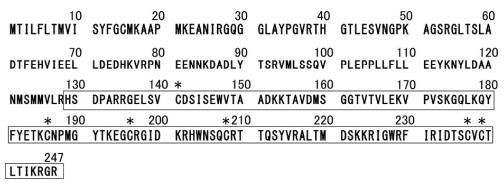| Identification | Back Directory | [Name]
BRAIN DERIVED NEUROTROPHIC FACTOR, HUMAN | [CAS]
218441-99-7 | [Synonyms]
BDNF
BNDF
RHBDNF
HUMAN BDNF
BDNF (HUMAN)
ProBDNF human
REC BDNF (HUMAN)
RECOMBINANT HUMAN BDNF
BRAIN DERIVED NEUROTROPIC FACTOR
BRAIN-DERIVED NEUROTROPHIC FACTOR
HUMAN BRAIN-DERIVED NEUROTROPHIC FACTOR
BRAIN DERIVED NEUROTROPHIC FACTOR, HUMAN
NEUROTROPHIC FACTOR, BRAIN DERIVED (HUMAN)
REC BRAIN-DERIVED NEUROTROPHIC FACTOR (HUMAN)
BRAIN DERIVED NEUROTROPHIC FACTOR, HUMAN, RECOMBINANT
BRAIN DERIVED NEUROTROPHIC FACTOR, HUMAN, RECOMBINANT, E COLI | [Molecular Formula]
C8H11NO4 | [MDL Number]
MFCD00285579 |
| Questions And Answer | Back Directory | [Discovery]
Barde et al. described the presence of a factor in a
glioma-conditioned medium that supported the survival
of embryonic sensory neurons and could be distinguished from nerve growth factor by immunological
and functional criteria. Furthermore, it was demonstrated
that the mammalian brain contained an activity similar to
that of the glioma-conditioned medium. Then, Barde
et al. purified a neuronal survival factor from the pig
brain, and identified it as BDNF, the second member of
the neurotrophin family. | [Structure]
BDNF is a polypeptide consisting of 119 aa residues. The human BDNF gene encodes a preproprotein
of 247 aa residues (preproBDNF) . After
cleavage, mature BDNF dimerizes through noncovalent interaction. BDNF has been identified in mammals, birds, reptiles,
amphibians, and teleosts. Mammalian
BDNF shows 100% homology. Six cysteines involved in
the intramolecular disulfide bond are conserved among
all vertebrate BDNFs.
 | [Properties]
Mr. 25,766 (mammalian preproBDNF); 12,300 (mam�malian mature BDNF). pI ≧ 10.1. BDNF is soluble in
water. Disulfide bridges are formed between Cys13 and
Cys80, between Cys58 and Cys109, and between Cys68
and Cys111 (in mammalian mature BDNFs). | [Gene, mRNA, and precursor]
The human proBDNF gene, BDNF, location 11p14.1,
consists of 12 exons. Human BDNF mRNA has 3827 bases
that encode a preproBDNF of 247 aa residues. ProBDNF shows biased expression in the brain (RPKM
3.0), the lung (RPKM 1.2), and 11 other tissues, including
the placenta and prostate. In the brain, higher levels of
expression are observed in the hippocampus, cerebellum,
and cerebral cortex. | [Synthesis and release]
BDNF mRNA levels are increased by development
and neuronal activity. BDNF release is also stimulated
by neuronal activity. BDNF is localized in a dense-core
vesicle in dendrites of the hippocampal neurons, suggesting that BDNF release is a type of regulated release. | [Receptors]
BDNF binds to at least two classes of receptors: tropomyosin receptor kinase B (TrkB), the high-affinity receptor, and p75NTR, the low affinity receptor.
Both TrkB and p75NTR are single-transmembrane receptors. The human NTRK2 gene encodes TrkB (Trk2) of 838
aa residues. The human NGFR gene encodes p75NTR of
427 aa residues. TrkB has a tyrosine-kinase domain in the
cytoplasmic region. There are two truncated isoforms
lacking the tyrosine-kinase domain.12 p75NTR has no
tyrosine-kinase domain. The binding activities of mature
BDNF are Kd=10 pM (TrkB) and 1 nM (p75NTR). | [Agonists and Antagonists]
BDNF, NT-3, NT-4, LM22A-4 (a synthetic, selective
partial agonist for TrkB), and HIOC (a selective agonist
for TrkB). ANA-12 (a selective, small-molecule noncompetitive
antagonist for TrrkB), and Cyclotraxin B (a selective, non�competitive antagonist or negative allosteric modulator
for TrkB). | [Biological functions]
TrkB is expressed in the central and peripheral nervous
systems. A higher level of expression is seen, especially in
the hippocampus, cerebellum, and cerebral cortex. The activation of TrkB induces the survival of neurons, promotes
the development of neuronal circuits, and induces synaptic
plasticity. The function of p75NTR is less clear. | [Clinical implications]
The expression level of BDNF is decreased in the entorhinal cortex of Alzheimer’s disease patients. Val66Met
mutation results in a reduction of hippocampal tissue. The mutation is reported in patients with learning and
memory disorders, anxiety disorders, and neurodegenerative diseases such as Alzheimer’s and Parkinson’s. Recently, it has been suggested that the modification of
BDNF-TrkB signaling could provide a potential therapeutic strategy for neurodegenerative diseases and neuropsychiatric disorders, including epilepsy. |
| Hazard Information | Back Directory | [Description]
Brain-derived neurotrophic factor is the second member of the neurotrophin-family trophic factors. BDNF is a polypeptide consisting of 119 amino acid residues, and forms a homodimer. There are two types of receptors binding to BDNF: tropomyosin receptor kinase B (TrkB), the high-affinity receptor, and p75NTR, the low affinity receptor. BDNF regulates the growth, maintenance, and survival of certain target neurons as well as the synaptic plasticity, learning, and memory through the activation of TrkB. On the other hand, the role of p75NTR is less clear. | [Uses]
Brain-derived neurotrophic factor (BDNF) recombinant human protein has been used as a supplement in various types of culture media. | [General Description]
The gene BDNF (brain derived neurotrophic factor) is mapped to human chromosome 11p14.1. BDNF is a member of the neurotrophin family of growth factors. The gene encodes a precursor protein, proBDNF. Mature BDNF (mBDNF) is synthesized by post-translational cleavage of proBDNF. Both proBDNF and mBDNF play crucial roles in cellular signaling. BDNF is expressed as the C-terminal portion of a 247 amino acid polypeptide precursor, which also contains a signal sequence of 18 amino acid residue and a propeptide of 110 amino acid residues. Recombinant human BDNF is a 27.0kDa homodimer of two 119 amino acid subunits linked by strong noncovalent interactions. | [Biochem/physiol Actions]
Like other members of this family, BDNF (brain derived neurotrophic factor) supports neuron proliferation and survival. BDNF can bind to a low affinity cell surface receptor called LNGFR (low-affinity nerve growth factor receptor), which also binds other neurotrophins such as NGF (nerve growth factor), NT-3 (neurotrophin-3) and NT-4. However, BDNF mediates its neurotrophic properties by signaling through a high affinity cell surface receptor called gp145/trkB (tropomyosin-related kinase B). BDNF also plays an important role in vascular function and participates in angiogenesis. It is involved in the pathogenesis of Alzheimer′s disease. ProBDNF interacts with p75 neurotrophin receptor, leading to long-term depression in the hippocampus. | [storage]
-20°C |
|
| Company Name: |
Sigma-Aldrich
|
| Tel: |
021-61415566 800-8193336 |
| Website: |
https://www.sigmaaldrich.cn |
|